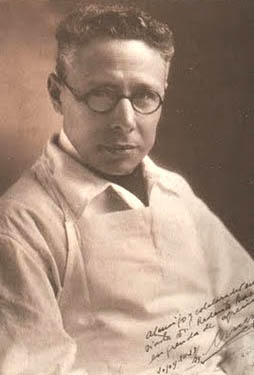Salvador Mazza facts for kids
Quick facts for kids
Salvador Mazza
|
|
|---|---|
 |
|
| Born | June 6, 1886 |
| Died | November 9, 1946 (aged 60) |
| Nationality | Argentinian |
| Alma mater | University of Buenos Aires |
| Known for | American trypanosomiasis |
| Scientific career | |
| Fields | Physician Epidemiology |
Salvador Mazza (June 6, 1886 – November 9, 1946) was an important Argentine doctor and scientist. He is famous for his efforts to control American trypanosomiasis, also known as Chagas disease. This illness was very common among poor people in rural areas of South America in the early 1900s.
Contents
Salvador Mazza's Amazing Work
Starting His Medical Journey
Salvador Mazza was born in Retiro, Buenos Aires, Argentina, in 1886. His parents, Francesco Mazza and Giuseppa Alfisi, were immigrants from Sicily. He grew up in a small town called Rauch. Salvador was a very smart student. He was accepted into a special high school, the Colegio Nacional de Buenos Aires, when he was only ten years old.
After high school, he wanted to join the Argentine Navy. However, he was not accepted because of his health. So, he decided to study medicine at the University of Buenos Aires (UBA). He graduated in 1903.
While studying, he worked as a Health Inspector in the countryside of Buenos Aires Province. He focused on preventing diseases and giving vaccinations. After graduating, he became an expert in microbiology (studying tiny living things) and pathology (studying diseases). He even managed a special place for sailors and immigrants who had cholera on Martín García Island. He then worked in hospitals in Europe before getting his Doctor of Medicine degree in 1910.
In 1914, he married Clorinda Brígida Razori. They became a great team, both in their marriage and in their work.
Fighting Diseases and Challenges
During World War I, in 1916, the Argentine Army sent Mazza to Europe. His job was to study how infectious diseases were affecting people in Germany and Austria-Hungary. There, he met Carlos Chagas, a famous Brazilian scientist. Chagas had discovered American trypanosomiasis (Chagas disease) in 1909.
In 1920, Mazza became the Laboratories Director at the Clinical Hospital and Dean of the Bacteriology Course at UBA. In 1923, he and his wife went to France. They worked with a famous scientist named Charles Nicolle at the Pasteur Institute in Algiers. They learned about Nicolle's methods for treating typhus. Nicolle later won the Nobel Prize in Physiology or Medicine for his work.
When Mazza returned to Argentina in 1925, he got an important job at the UBA Surgical Clinic. He invited Charles Nicolle to Buenos Aires. They talked about how important it was to fight the contagious diseases affecting poor people in Argentina.
These talks led to a medical mission in Argentina's northern region. This area was not well developed. The Regional Pathologies Study Mission (MEPRA) started in Jujuy Province in February 1926.
Mazza's lab was set up in a railway car. This mobile lab traveled from village to village. They studied diseases like trypanosomiasis and leishmaniasis. They also taught people, who were mostly unable to read, about their common diseases. They worked to control the Triatoma infestans bug, known locally as vinchuca. This bug carries the disease.
In 1926, a sick dog died. This helped Mazza confirm that the germ causing Chagas disease, called Trypanosoma cruzi, was present in Argentina. This happened in 1927.
Mazza created Scientific Societies in seven northern provinces between 1926 and 1927. This helped him organize his studies and share information. He had help from other doctors, like Dr. Guillermo Paterson, who studied malaria.
However, Mazza faced problems. Rich landowners in the area were not interested in his work. They thought poverty and disease were not their problem. They also worried that Mazza's efforts might cause problems with the local people. His plan to burn old thatched roofs, where the vinchuca bugs lived, was very unpopular.
In 1930, there was a change in government. This led to MEPRA losing its funding the next year. But Mazza kept the mission going with donations and his own money. His hard work made the doctors in South America accept that Chagas disease was a real problem. It became a special topic at a big medical conference in 1939. He also provided the first detailed information about how living conditions, Chagas disease, and the insect that carries it are connected.
In 1942, Mazza wrote to the famous Scottish scientist, Dr. Alexander Fleming. This led to Mazza helping to set up the first Argentine factory for penicillin in 1943. This happened even though the government still refused to help. By 1944, the MEPRA had published 551 articles in scientific journals. Mazza himself wrote 482 of them.
In November 1946, he was invited to a meeting about Brucellosis in Monterrey, Mexico. On November 9, 1946, Dr. Salvador Mazza suddenly became very ill and died at age 60. He likely died from Chagas disease, the very illness he had worked so hard to control in Argentina.
MEPRA continued its work until 1959. Budget cuts forced its last lab to close. Salvador Mazza's story was made into an Argentine movie in 1995 called Casas de fuego ("Houses of Fire").
See also
 In Spanish: Salvador Mazza para niños
In Spanish: Salvador Mazza para niños

